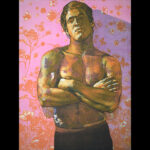 First-year student Margaret Sharapan used to think of fine art and design as “two branches on a tree,” but Foundations class Understanding the Visual 1 has shown her they are “co-dependents that give and take from one another.”
First-year student Margaret Sharapan used to think of fine art and design as “two branches on a tree,” but Foundations class Understanding the Visual 1 has shown her they are “co-dependents that give and take from one another.”
On December 8, the entire Foundations class gathered as eleven of the first-year students, one from each of the eleven UV-1 class sections, reflected on the course and the value they received from it. Founded in Japan, Pecha Kucha presentations are fast-paced talks, in which a speaker discusses a subject while 20 related slides are shown for 20 seconds each.
MIAD’s Pecha Kucha gave each student five minutes. The students created slideshows filled with their work, images from their notebooks, quotes and other visuals that represented their learning.
“It was nice to have something that really forced me to think over what we had accomplished, and how the small assignments totaled up to a pretty profound change in my thinking,” Sharapan said of the Pecha Kucha assignment. The faculty voted her as having given the night’s best presentation.
Understanding the Visual 1 focuses on visual cultures and presentation, and on integrated experience and inquiry. By exploring topics fundamental to all areas of art and design, students develop skills in research, presentation, critique and discussion to foster critical thinking. The class seeks to develop students’ abilities to formulate arguments and defend positions relevant to today’s culture, through initiating an historical and contemporary context for art and design.
“This course is at the cutting-edge of art and design education. We create a studio learning experience by inviting students to think and connect ideas with their faculty, who are art historians and artists and designers,” said David Martin, Vice President of Academic Affairs.” This course is the cornerstone for what we are trying to achieve in our new curriculum.”
UV-1 is part of MIAD’s First-Year Experience, an exploration of new ways of seeing, thinking and creating. Inquiry and research-based modes of learning help first-year students connect and contextualize the works they are creating. Students explored their personal creative processes in Research, Practice and Methods courses, while learning about context in UV-1. A recent RPM exhibition at MIAD featured class projects by all of the Foundations students.
Sharapan’s Pecha Kucha presentation on her UV-1 class focused on ‘gestalt,’ the thought that “the whole object is greater than the sum of its parts.” She believes it is the unsaid theme of UV-1. To Sharapan, placing art or design in its proper context is one of the keys in this principal.
Foundations year at MIAD is a holistic preparation for becoming a visual creator. First-year students experiment, overcome hurdles and challenge their own preconceived notions about art and design while building their futures.
“You can’t just take things at face value, you have to contextualize them. You have to relate it to yourself,” Sharapan said. “You have to ask ‘why’ to try to understand how something came about. To understand what it is, you have to know where it came from.”
Sharapan learned about the importance of personal perspective throughout the class. She reflected that artists and designers must be aware of their own perspective, and should try to look at their own work as their audience would.
 The students voted Foundations student Josh Christensen’s presentation. He talked about the importance of having fun while creating art because it makes the creation process more enjoyable and allows artists to express themselves more fully.
The students voted Foundations student Josh Christensen’s presentation. He talked about the importance of having fun while creating art because it makes the creation process more enjoyable and allows artists to express themselves more fully.
Christensen said the class taught him to see with an “artist’s eye,” taking time to notice details and beauty he had previously overlooked. He, along with several other students, cited a field trip that examined Kohler kitchen and bathroom fixtures as a perfect example of it.
“I wanted mine to reflect not only what I’ve learned in class but also what I’ve learned just being here at MIAD,” Christensen said of his presentation. “Really the main theme of my speech was that I’ve learned to be myself not only in my art but also in life. UV-1 has helped me be able to express myself in my art.”
Christensen drove home his theme of having fun as he walked back from the podium to his seat as the song “Express Yourself” played.
“I was in awe of many of the students’ presentations. By presenting their work in Pecha Kucha presentations, they are becoming self-directed and reflective learners, characteristics that are essential in art and design,” Martin said. “They are taking a stance, identifying who they are. Our students are getting in the habit of making smart presentations from the get-go.”

Click here to learn more about the MIAD first-year experience.
Top image: A page from Margaret Sharapan’s notebook.
Middle image: An image from Josh Christensen’s presentation.
Bottom image: Foundations students look on as one of the 11 presenters gives her Pecha Kucha presentation.





